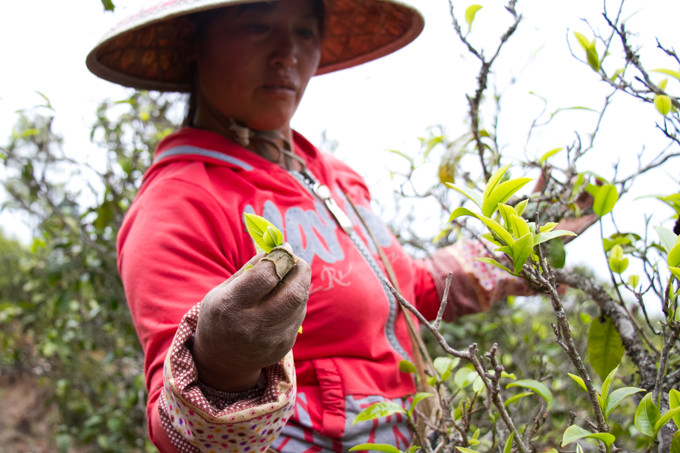- HOME >
- New Arrival at HOJO Online Shop
New release of Bai Shu Black Tea from Yunnan
- [2017.03.28] Posted By Akira Hojo
We have just released Bai Shu Black Tea. This is the black tea version of the tea produced only from the tealeaf collected from white tea trees. In 2016, we have released the raw pu-erh tea version named as Bai Shu Raw Pu-erh Tea. Both teas are made of the tealeaf specifically collected from tea trees with white tea trunk.
Tea leaf collected from a white bush
Usually, one tea garden consists of various kinds of tea tree, e.g., young and old tea tree, big and small tea tree, and tea tree grown under the shade or under the direct sun shine. I wanted to collect tea leaves from the specific group of tea tree and process it into tea. Throughout the years of my tea expedition in Yunnan, I have met a tea manufacturer who has both the manufacturing facility and processing skills to support my idea. I personally collect the fresh tea leaves and ask him to process it. The type of tea tree that I was interested in particular was the “White Tea Bush”. In the natural farming tea garden, some tea trees become very white if they are grown without fertilizer and always expose to strong sun light. In early spring of 2016, I have specified this type of tea trees and part of the tea was made into raw pu-erh tea, while the rest was processed into black tea.
We kept tea for a while for maturation
We selected exactly the same type of tea trees that was used for producing Bai Shu Raw Pu-erh Tea. The tea garden is situated at about 2000m in the west of Lincang region. After receiving this tea in spring 2016, we conducted baking using our own oven and kept the tea for a while in order to let it matured. The flavor of freshly made black tea is a little greenish. It also gives astringent taste and noise in flavor.
It is very important for us to conduct moderate baking in order to further enhance the quality. Usually the flavor of tea becomes lighter right after the baking. So it is important to keep it for a few months without oxygen so as to enhance the flavor.
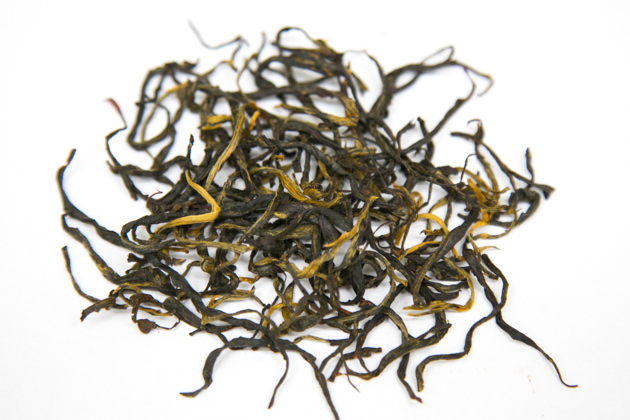
Shabby and white outlook
If tea tree is grown without fertilizer, it grows very slowly due to nitrogen deficiency. As a result of slower growing speed, the plant tends to slow down the overall photosynthesis. Under the circumstances, there is a very interesting phenomenon. Some of tree branches naturally dry out, and the number of tealeaf is reduced. Those tea trees show a very noticeable characteristic. The tree bark turns very white, like white birch tree. Interestingly, once the fertilizer is re-applied, the white tree becomes brown color again. Comparatively, those “white tea trees” have very less branches and leaves. Generally people may think it is very unhealthy tree or the tree is dying. However, the tealeaf from this white tree is very sweet. It is not only sweet, but also giving a very clear and refreshing aftertaste. The tealeaf from the white tea tree does not give bitter or astringent taste that normal tea does. Perhaps the tealeaf grown under harsh environment becomes very rich in natural substances.
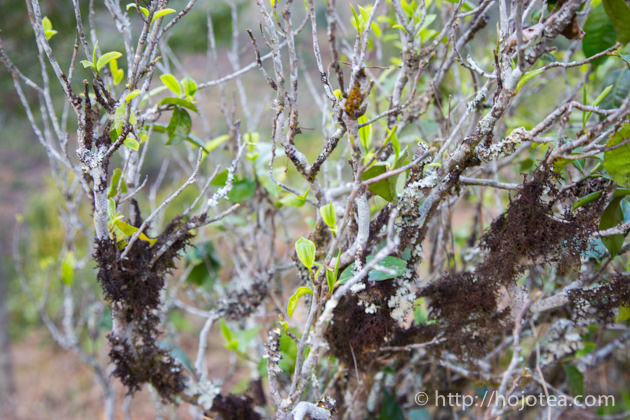


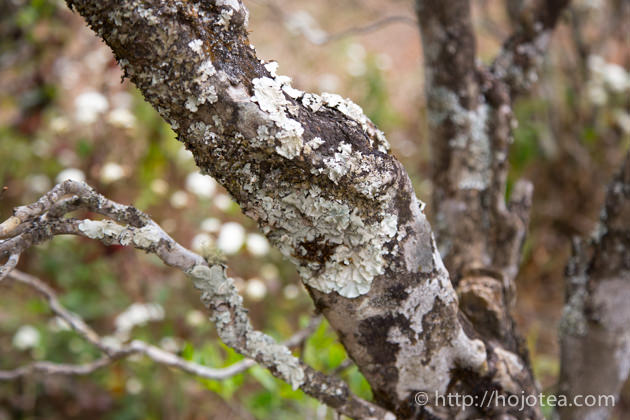
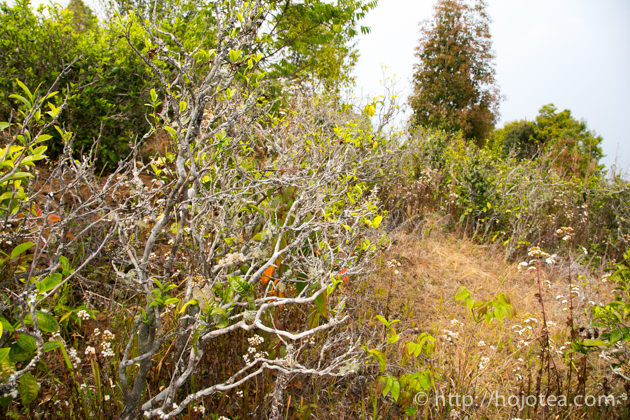



Making Tea from specially selected leaves
I have been always interested in collecting only the specific type of tea leaves. My standard pu-erh teas are collected from natural farming garden too. However, usually the tea garden covers wide area and tea trees scatter everywhere. Somehow there is a variety of tea tree. Some of trees grown under shade, some are directly expose to sunshine, some are very old trees and due to unknown factors some of them grow faster. The taste of tea grown under direct sun light and under shade is somehow different. When tea leaves are gathered from entire gardens and processed together, the taste of tea is homogenized.

We worked with a tea collector
For the first time in last year, I wanted to produce tea collected only from the white tea tree grown under direct sun light. I am interested in making tea with a distinctive characteristic. For achieving my desire, I had to selectively collect tea leaves from specific tea tree with very white tree bark.
There are two ways for us to collect the fresh tea leaves. If we directly deal with farmer who owns the gardens, the cost is lower. However, this method does not produce a good outcome. In general, farmers pluck the fresh tealeaf and sell it to the tea manufacturer. Their earning comes from the total weight of tealeaf they gathered in a day. In other words the more tealeaves the more earning, hence the plucking is very random and very likely that the tealeaf from non-white tea trees will be collected and mixed. Eventually farmers tend to pluck tealeaf that does not meet our requirements. As we wish to collect the specific kind of tealeaf, we appoint professional fresh tealeaf collector. They live in the village, and they are very familiar and truly understood the condition of each tea tree. They are very good in management and they will follow the requirement of their client and lead the farmers to pluck according to the specification. I have asked help from my pu-erh tea manufacturer to introduce a reliable fresh tealeaf collector. She was indeed very competent and worked very hard to collect the tealeaf from the white tea trees.
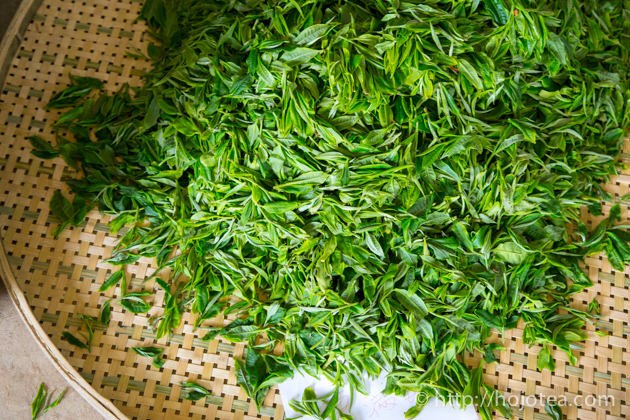

It looks like a bush. But it actually is a tea garden
Following 4 photos show common tea tree
Even if the tea tree is very old, it is not certainly that tea trunk is white. The color of tea trunk becomes brownish when fertilizer is being applied.



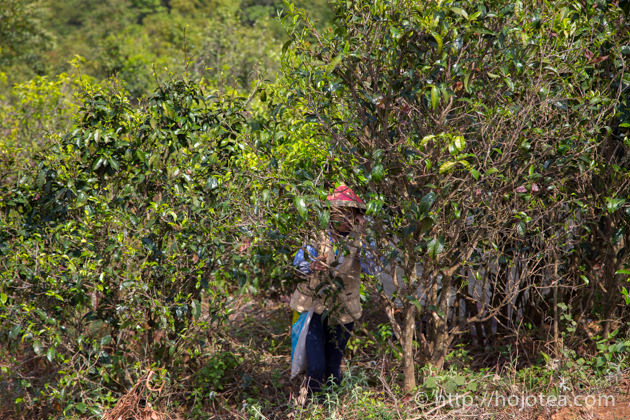
High clarify in taste
I was very surprised by the taste of this tea when I drunk it for the first time. It was not like the taste of classic black tea at all. This Bai Shu Black Tea tastes very clear and transparent. It has clarity in taste reminiscent of wild tea.
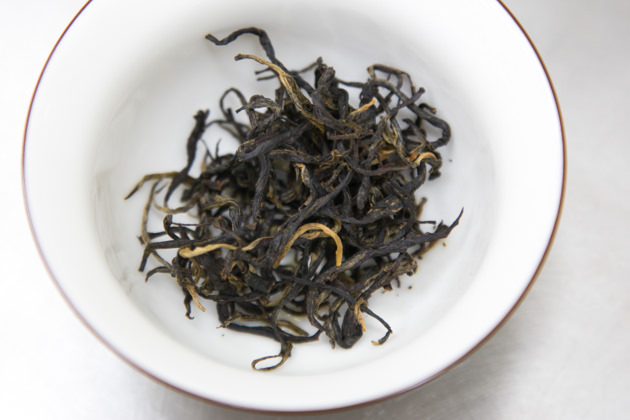
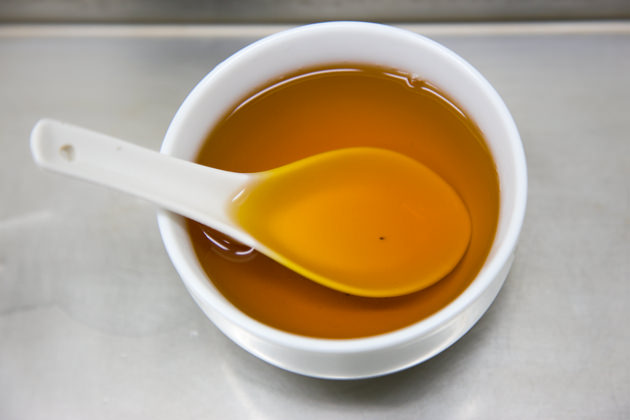
In fact, it is not very easy to understand the clarity in tea taste. I have been dealing with many kinds of tea in past 10 years. Only recent years I came across with so-called clarity in taste. This is the distinctive impression in taste that appears when tea is left like wild tea tree. We can detect the same kinds of taste when we taste the wild herbs and vegetable, wild fish or wild mushroom. These natural wild materials give a clear taste. Clear does not mean light. Indeed its clear or clean taste has very long-lasting finishing. If you try this tea for the first time, you may feel that the taste is light. However, you will soon realize that it is actually not light but clean.
The process of this tea is very well-managed. It gives no unpleasant odor such as over-baked flavor. The flavor of this tea will be getting stronger if it is kept longer. We adjusted the moisture at around 3%. Because of the lower moisture, it has slight astringency when the bag of tea is just opened. Nevertheless, the taste will become mellow in a few days as it slowly absorbs moisture from the environment. We prefer to keep the initial moisture to be low for better storage.
Related Articles
How to get the latest update on HOJO?
1. Follow Twitter, 2. Click "Like" on Facebook, and 3. Subscribe in newsletter. You can have the latest tea news from HOJO.
 Subscribe the Newsletter to enjoy the privileges
Subscribe the Newsletter to enjoy the privileges- You may receive a free sample upon purchase, or you may have the priority to purchase special products. So please remember to subscribe our newsletter as well as the social network.
- Myanmar White Tea Bud 2013 from Guo Gan, Myanmar
- We have released a raw Pu-erh tea, 緬甸白芽茶 2013 (Myanmar White Tea Bud 2013), produced by ethnic minorities in t …
- Yong De Wild White Tea 2025 Loose Leaf Limited Release
- We have released Yong De Wild White Tea Loose 2025. For the 2025 harvest, only the loose-leaf type was …
NEW ARTICLES
 Myanmar White Tea Bud 2013 from Guo Gan, Myanmar
Myanmar White Tea Bud 2013 from Guo Gan, Myanmar- We have released a raw Pu-erh tea, 緬甸白芽茶 2013 (Myanmar White Tea Bud 2013), produced by ethnic minorities in t …
 Yong De Wild White Tea 2025 Loose Leaf Limited Release
Yong De Wild White Tea 2025 Loose Leaf Limited Release- We have released Yong De Wild White Tea Loose 2025. For the 2025 harvest, only the loose-leaf type was …
 Experience the True Freshness of Raw Pu-erh : Tang Jia 2025 Loose Leaf Release
Experience the True Freshness of Raw Pu-erh : Tang Jia 2025 Loose Leaf Release- We have released Tang Jia Raw Pu-erh Tea 唐家古樹生茶 2025 Loose Leaf. Among HOJO’s raw pu-erh teas, Tang Jia Raw Pu …
 Yunnan Chun Jian Green Tea from High Mountain Gardens
Yunnan Chun Jian Green Tea from High Mountain Gardens- Yunnan Chun Jian Green Tea is now available. This tea is made from naturally grown leaves harvested from high …
 Limited Loose Leaf Release of 2025 Da Xue Shan Wild Raw Pu-erh Tea
Limited Loose Leaf Release of 2025 Da Xue Shan Wild Raw Pu-erh Tea- We have released the 2025 loose-leaf version of Da Xue Shan Wild Raw Pu-erh Tea. This tea comes from wild tea …
 Discover a New Way to Enjoy Tea: Cooking Rice with Tea
Discover a New Way to Enjoy Tea: Cooking Rice with Tea- Cooking rice with tea is a simple idea, but it brings surprisingly satisfying results. The tea’s flavour seeps …
 2025 Da Xue Shan Wild White Tea Now Available from Yunnan
2025 Da Xue Shan Wild White Tea Now Available from Yunnan- The 2025 harvest of Da Xue Shan Wild White Tea is now available. Crafted from truly wild Camellia taliensis tr …
 Fresh 2025 Yunnan White Tea – Select Your Favourite Lot Before Blending
Fresh 2025 Yunnan White Tea – Select Your Favourite Lot Before Blending- Freshly crafted in Yunnan and just arrived in KL, our new 2025 white tea is now available at our Gardens Mall …
 2024 Dong Shan Raw Pu-erh Tea – Crafted with the Producer for Desired Quality
2024 Dong Shan Raw Pu-erh Tea – Crafted with the Producer for Desired Quality- We have released the 2024 cake of Dong Shan Raw Pu-erh Tea. Earlier, we offered the loose-leaf version from th …
 Development of Firewood Roasted Hojicha Using Naturally Grown Tea from Yunnan
Development of Firewood Roasted Hojicha Using Naturally Grown Tea from Yunnan- We are currently staying in Yunnan Province for tea production. As the season nears its end, tea trees with pa …
Category
- New Arrival at HOJO Online Shop
- Featured Articles
- Newsletter
- Types of Tea
- Origin of Tea
- Teapot and Tea Equipment
- Tea Column
- How to enjoy tea
- Tea Processing
- How to choose quality tea
- Tea constituents and functional effect
- Safety of Tea
- Foods
- Tea Business Operation
- Hobby and Outdoor Activity
- Ranking of Tea
- Video
- FAQ
- Media Release
Profile

- AKIRA HOJO
- I invite you to experience my tea selections.I was born in Nagano, Japan. In university, I studied agricultural chemistry, and I have the master degree in food science. I worked in Japanese food industry for 10 years. I involved in R&D, QC and QA. As a factory manager, I implemented ISO9000 series and managed the factory.
- The Art of Tea Magazine
- We posted the article on “The Art of Tea Magazine No.9, the magazine is published in Taiwan. We featured …
- New Straits Times
- The Malaysian National Newspaper, New Straits Times featured HOJO Tea on 17-Oct-2007.
Shop Info

Address:Lot No. T-215, 3rd Floor, The Gardens Mall, Mid Valley City, Lingkaran Syed Putra, 59200 Kuala Lumpur
Tel: +603-2287-4537
Business Hour: 10am to 10pm

